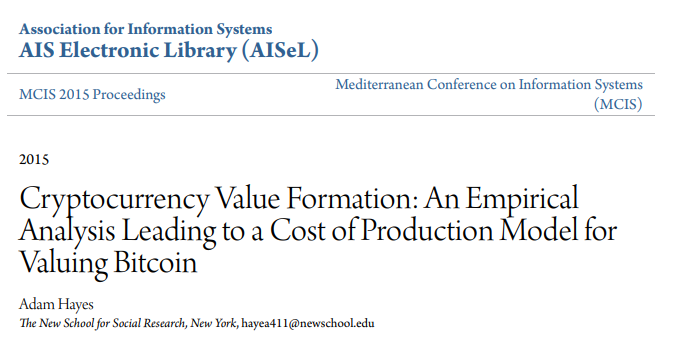
1 Empirical Analysis to Define Which Factors are
Determinants in Cryptocurrency Value Formation
1.1 Introduction
Due to Bitcoin’s growing popular appeal and merchant acceptance, it has become increasingly
important to try to understand the factors that influence its value formation. However, price
fluctuations of bitcoin versus national currencies such as the U.S. dollar, euro or Chinese yuan,
have been extremely volatile. This extreme price volatility produces a lot of noise which
makes meaningful analysis difficult. In fact, there is increasing evidence that the rise in price
for one bitcoin to over $1,000 around December 2013 was largely caused by coordinated price
manipulation at the Mt. Gox exchange involving fraudulent trading algorithms which pilfered
customer accounts. The subsequent failure of the Mt. Gox exchange and the associated cus-
tomer accounts was likely a direct result of this market manipulation. Fortunately, there is an
active and fairly liquid market for various altcoin–bitcoin trading pairs. By looking at bitcoin-
denominated relative prices and removing the external dollar, euro, yuan, etc. exchange rates,
much of the noise and price volatility can be removed, making for a much better analysis of
the data. Comparing how the variations in several shared attributes of cryptocurrencies affects
their relative prices with bitcoin, factors that influence value formation can be identified.
This paper describes a cross-sectional data analysis of 66 cryptocurrencies in such a man-
ner using objective factors shared by each one of them. The findings indicate that relative val-
ue formation occurs in production at the margin, much like other commodities.
1.2 A brief overview of Bitcoin
The technical specifications of the Bitcoin and altcoin protocols are beyond the scope of this
paper, however some key points must be understood before going any further, under the as-
sumption that many readers have little to no prior knowledge of this topic.
Taking bitcoin as the generic example, one can then extend those concepts to the greater
universe of altcoins. This overview is purposefully brief and meant only to clarify some points
that will be referred to in this paper.
Bitcoin is an open source software-based online payment system that emerged in 2008-
2009. Payments are recorded in a shared public ledger using its own unit of account, which is
also called bitcoin, symbolically BTC.
Transactions occur peer-to-peer without a central repository or single administrator – it is a
decentralized virtual currency which also can be completely anonymous. New bitcoins are cre-
ated as a reward for transaction processing work in which users offer their computing power to
verify and record payments into the public ledger. Also known as “mining”, individuals or
companies engage in this activity in exchange for the chance to earn newly created blocks of
bitcoins.
Mining is carried out by specialized hardware which has a certain amount of computation-
al power, measured in hashes per second. The aggregate bitcoin network has a cumulative
computational power additive of all the mining effort employed around the world. For every
one GigaHash/second (GH/s) any individual miner puts online, for example, that amount will
be added to the overall network power. Mining is quite competitive, in the sense that some-
body mining with more computational power or with greater efficiency has a better chance of
finding a block than somebody with less. Computational effort in cryptocurrency production is
often referred to as alternatively hashpower, hashing power, mining effort, or hashrate.
Besides mining, bitcoins can be obtained in exchange for currencies such as dollars, euros,
etc., for other altcoins, or in exchange for products, and for services. Users can send and re-
ceive bitcoins electronically using 'wallet' software on a personal computer, mobile device, or
a web application.
1.3 A short survey of relevant literature
There is a new and emerging academic literature regarding cryptocurrencies, with most em-
phasis surrounding Bitcoin. Much of the economic study undertaken has attempted to address
the “moneyness” of bitcoin or whether it is more analogous to a fiat versus commodity money,
like a 'digital gold' (Gertchev, 2013) (Harwick, 2014) (Bergstra, 2014).
Yermack (2013) looks at bitcoin's moneyness and points out weaknesses in bitcoin as a
currency. Yermack claims that bitcoin (and all cryptocurrencies by association) have no intrin-
sic value. I consider the potential that while its characteristics are intangible and the labor em-
ployed to mine for them is computational rather than human or mechanical, a bitcoin does in-
deed have an intrinsic value, albeit virtual, which cannot be directly compared to tangible in-
trinsic value possessed by gold, for example. I don't disagree with the premise that bitcoin and
its cousins are not money in the strict sense and that many issues stand in the way of it moving




